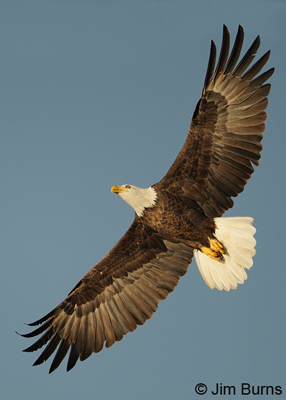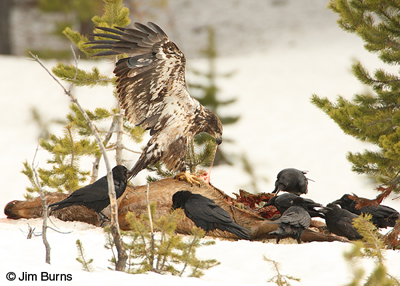
QUESTIONS
1—Bald Eagles construct the largest nests of any bird in North America?
2—The Bald Eagle has the largest wingspan of any North American bird?
3—The Bald Eagle was the mascot of my high school athletic teams?
4—The Bald Eagle’s voice is seldom, if ever, heard in movies?
5—The historical decline of the Bald Eagle was mainly due to two things: habitat loss and recreational activity in nesting territories?
6--Bald Eagles may take up to five years to reach sexual maturity and full adult plumage?
7—Bald Eagles are sexually dimorphic?
8—In colonial times Bald Eagles were shot because it was believed they would carry off human newborns?
9—Bald Eagles have been known to hunt cooperatively?
10—Bald Eagles are kleptoparasitic?
11—Bald Eagles are migratory?
12—Ben Franklin first proposed making the Bald Eagle the symbol of our nation?
13—The preferred food of Bald Eagles is fish?
14—Bald Eagles cannot take other birds live, but they are scavengers and will readily feed on dead birds and other carrion.
15—The Bald Eagle’s common name derived from the adult’s white head feathers?
16—In winter the easiest place to see Bald Eagles in Arizona is along the Salt River?
17—During nesting season the easiest place to see Bald Eagles in Arizona is along the Salt River?
18—Bald Eagles did not receive federal protection until the middle of the 20th century?
19--Bald Eagles are endemic to North America?
20—The densest nesting Bald Eagle area in Arizona is the White Mountains with its many stocked fishing lakes?
ANSWERS
1—TRUE.
2—FALSE. That distinction goes to the California Condor whose wingspan can reach 9 feet. The Bald Eagle comes in second with a wingspan which can reach just over 8 feet.
3—FALSE, but I’ll give you half a point if you said true because by any logic it should have been Bald Eagle rather than the Golden Eagle that it was. Golden Eagles are very uncommon in northwest Missouri, and I’ve never seen one in that state. However, at Loess Bluffs National Wildlife Refuge, which is less than an hour from my hometown, Bald Eagles are considered, not just common, but abundant in the winter.
4—TRUE. The call of the Bald Eagle is a high pitched, descending “chatter” which sounds nothing like you’d expect from a large raptor symbolic of a powerful nation. Hollywood always uses the scream of the Red-tailed Hawk instead, even if a Bald Eagle is contextual for the film.
5—FALSE. The two major reasons for the Bald Eagle’s decline, prior to its protection under federal law, were DDT and indiscriminate shooting.
6—TRUE.
7—TRUE. The female is 25% larger than the male, averaging 12 pounds, whereas males average 9 pounds
8—TRUE. But that belief was false. The Bald Eagle carrying capacity is five pounds max. Chickens yes, babies, no, although early in our country’s history the average birth weight was just over six pounds.
9—TRUE. There are records of them doing this in Utah with Jackrabbits and in Florida with Cattle Egrets.
10—TRUE. They commonly steal fish from Osprey and smaller birds such as gulls and herons. I’ve even seen this here in Arizona where Bald Eagles densities are very low compared to coastal areas where kleptoparasitism is observed frequently.
11—TRUE. Bald Eagle movements and migrations are complex. Young birds migrate and move nomadically. In Arizona, for example, two and three year olds go north in late spring and summer, but return in September and October. Nesting adults here are resident, but there is an influx in the state in winter as northern birds come south seeking open water with fish.
12—FALSE. Franklin proposed the Wild Turkey, but was outvoted.
13—TRUE. Fish comprise about 75% of the Bald Eagle diet?
14—FALSE. Although success rate is low, Bald Eagles will commonly stoop on flocks of ducks and shorebirds. I once watched one capture two American Coots, one with each foot, simultaneously, and fly off with both at Bosque del Apache in New Mexico.
15—TRUE. The word “bald” comes from the Middle English word, “balled” which means “shining white.”
16—FALSE. The winter influx of Bald Eagles into Arizona is most noticeable around Mormon Lake south of Flagstaff, and that area is “can’t miss” at that time of year.
17—FALSE. There is a pair of Bald Eagles which has nested for years in south Scottsdale. Although the nest itself is not publicized and is on private property, the eagles from this nest fish regularly at Chaparral Lake on the Scottsdale Greenbelt.
18—TRUE. Bald Eagles were considered “vermin” like rats and wolves, a menace to livestock and competition for hunters. They were commonly shot on sight prior to 20th century federal law protection.
19—TRUE, but only if you consider Mexico part of North America. They do nest in northern Mexico.
20—FALSE. The densest breeding area here is the lower Verde River with eight territories between Bartlett Lake and the confluence with the Salt River.
Congratulations. If you scored above 12 on this quiz, you’re either a serious birder or a Bald Eagle aficionado. If you scored over 16, you’re either a Bald Eagle expert or you work for Arizona Game and Fish.